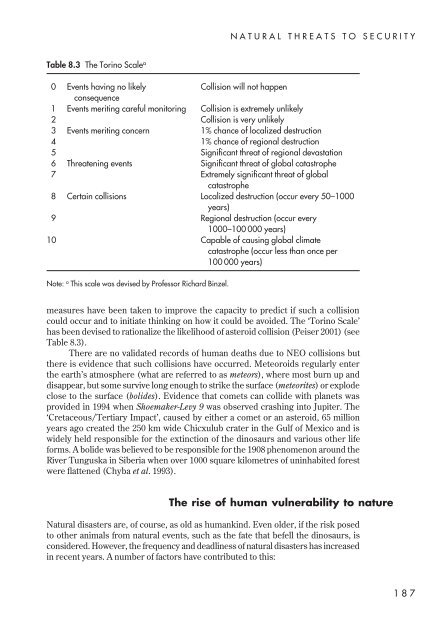Understanding global security - Peter Hough
Understanding global security - Peter Hough
Understanding global security - Peter Hough
Create successful ePaper yourself
Turn your PDF publications into a flip-book with our unique Google optimized e-Paper software.
NATURAL THREATS TO SECURITY<br />
Table 8.3 The Torino Scale a<br />
0 Events having no likely Collision will not happen<br />
consequence<br />
1 Events meriting careful monitoring Collision is extremely unlikely<br />
2 Collision is very unlikely<br />
3 Events meriting concern 1% chance of localized destruction<br />
4 1% chance of regional destruction<br />
5 Significant threat of regional devastation<br />
6 Threatening events Significant threat of <strong>global</strong> catastrophe<br />
7 Extremely significant threat of <strong>global</strong><br />
catastrophe<br />
8 Certain collisions Localized destruction (occur every 50–1000<br />
years)<br />
9 Regional destruction (occur every<br />
1000–100 000 years)<br />
10 Capable of causing <strong>global</strong> climate<br />
catastrophe (occur less than once per<br />
100 000 years)<br />
Note: a This scale was devised by Professor Richard Binzel.<br />
measures have been taken to improve the capacity to predict if such a collision<br />
could occur and to initiate thinking on how it could be avoided. The ‘Torino Scale’<br />
has been devised to rationalize the likelihood of asteroid collision (Peiser 2001) (see<br />
Table 8.3).<br />
There are no validated records of human deaths due to NEO collisions but<br />
there is evidence that such collisions have occurred. Meteoroids regularly enter<br />
the earth’s atmosphere (what are referred to as meteors), where most burn up and<br />
disappear, but some survive long enough to strike the surface (meteorites) or explode<br />
close to the surface (bolides). Evidence that comets can collide with planets was<br />
provided in 1994 when Shoemaker-Levy 9 was observed crashing into Jupiter. The<br />
‘Cretaceous/Tertiary Impact’, caused by either a comet or an asteroid, 65 million<br />
years ago created the 250 km wide Chicxulub crater in the Gulf of Mexico and is<br />
widely held responsible for the extinction of the dinosaurs and various other life<br />
forms. A bolide was believed to be responsible for the 1908 phenomenon around the<br />
River Tunguska in Siberia when over 1000 square kilometres of uninhabited forest<br />
were flattened (Chyba et al. 1993).<br />
The rise of human vulnerability to nature<br />
Natural disasters are, of course, as old as humankind. Even older, if the risk posed<br />
to other animals from natural events, such as the fate that befell the dinosaurs, is<br />
considered. However, the frequency and deadliness of natural disasters has increased<br />
in recent years. A number of factors have contributed to this:<br />
187
















